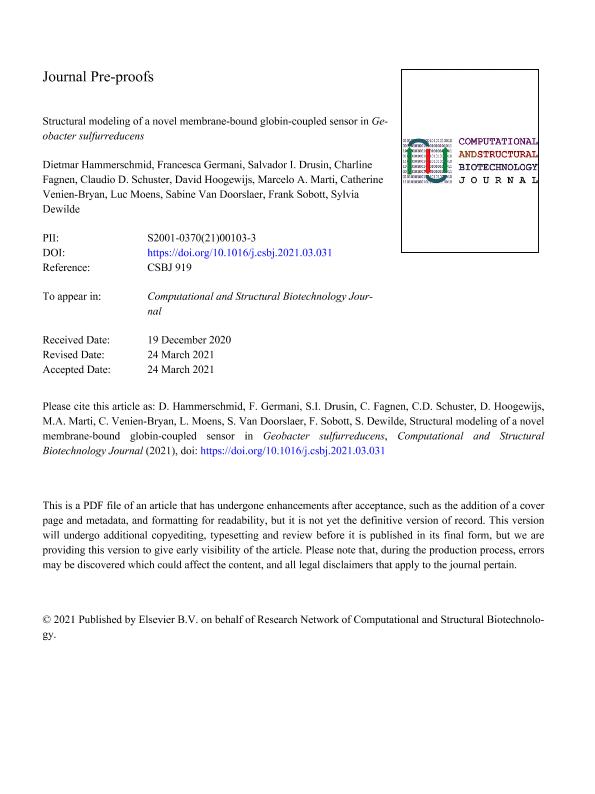Artículo
Structural modeling of a novel membrane-bound globin-coupled sensor in Geobacter sulfurreducens
Hammerschmid, Dietmar; Germani, Francesca; Drusin, Salvador Iván ; Fagnen, Charline; Schuster, Claudio David
; Fagnen, Charline; Schuster, Claudio David ; Hoogewijs, David; Marti, Marcelo Adrian
; Hoogewijs, David; Marti, Marcelo Adrian ; Venien Bryan, Catherine; Moens, Luc; Van Doorslaer, Sabine; Sobott, Frank; Dewilde, Sylvia
; Venien Bryan, Catherine; Moens, Luc; Van Doorslaer, Sabine; Sobott, Frank; Dewilde, Sylvia
 ; Fagnen, Charline; Schuster, Claudio David
; Fagnen, Charline; Schuster, Claudio David ; Hoogewijs, David; Marti, Marcelo Adrian
; Hoogewijs, David; Marti, Marcelo Adrian ; Venien Bryan, Catherine; Moens, Luc; Van Doorslaer, Sabine; Sobott, Frank; Dewilde, Sylvia
; Venien Bryan, Catherine; Moens, Luc; Van Doorslaer, Sabine; Sobott, Frank; Dewilde, Sylvia
Fecha de publicación:
03/2021
Editorial:
Elsevier
Revista:
Computational and Structural Biotechnology Journal
ISSN:
2001-0370
Idioma:
Inglés
Tipo de recurso:
Artículo publicado
Clasificación temática:
Resumen
Globin-coupled sensors (GCS) usually consist of three domains: a sensor/globin, a linker, and a transmitter domain. The globin domain (GD), activated by ligand binding and/or redox change, induces an intramolecular signal transduction resulting in a response of the transmitter domain. Depending on the nature of the transmitter domain, GCSs can have different activities and functions, including adenylate and di-guanylate cyclase, histidine kinase activity, aerotaxis and/or oxygen sensing function. The gram-negative delta-proteobacterium Geobacter sulfurreducens expresses a protein with a GD covalently linked to a four transmembrane domain, classified, by sequence similarity, as GCS (GsGCS). While its GD is fully characterized, not so its transmembrane domain, which is rarely found in the globin superfamily. In the present work, GsGCS was characterized spectroscopically and by native ion mobility-mass spectrometry in combination with cryo-electron microscopy. Although lacking high resolution, the oligomeric state and the electron density map were valuable for further rational modeling of the full-length GsGCS structure. This model demonstrates that GsGCS forms a transmembrane domain-driven tetramer with minimal contact between the GDs and with the heme groups oriented outward. This organization makes an intramolecular signal transduction less likely. Our results, including the auto-oxidation rate and redox potential, suggest a potential role for GsGCS as redox sensor or in a membrane-bound e−/H+ transfer. As such, GsGCS might act as a player in connecting energy production to the oxidation of organic compounds and metal reduction. Database searches indicate that GDs linked to a four or seven helices transmembrane domain occur more frequently than expected.
Archivos asociados
Licencia
Identificadores
Colecciones
Articulos(IQUIBICEN)
Articulos de INSTITUTO DE QUIMICA BIOLOGICA DE LA FACULTAD DE CS. EXACTAS Y NATURALES
Articulos de INSTITUTO DE QUIMICA BIOLOGICA DE LA FACULTAD DE CS. EXACTAS Y NATURALES
Citación
Hammerschmid, Dietmar; Germani, Francesca; Drusin, Salvador Iván; Fagnen, Charline; Schuster, Claudio David; et al.; Structural modeling of a novel membrane-bound globin-coupled sensor in Geobacter sulfurreducens; Elsevier; Computational and Structural Biotechnology Journal; 19; 3-2021; 1874-1888
Compartir
Altmétricas



